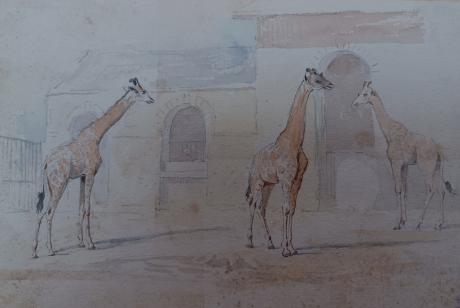The Giraffe House at London Zoo, built in 1837, is the world's oldest zoo building still used for its original purpose. The Giraffe House has been designated as a Grade II listed building because of its historical and architectural significance.
The initial grounds were laid out in 1828 by Decimus Burton, the zoo's first official architect from 1826 to 1841, made famous for his work on the London Colosseum and Marble Arch. Burton's work began with the Clock Tower in 1828 above what was then the llama house, which today is the first aid kiosk. In 1830, the East Tunnel, which linked the north and south parts of the zoo together for the first time, was completed, which also acted as a bomb shelter during the Second World War. Burton concluded his work in 1837 with the Giraffe House, which, due to its functional design, still remains in use as the zoo's giraffe enclosure in the Into Africa exhibit.
Being purpose-built for giraffes, the brick ‘shed’ was suitably tall, reaching 6.5m (21 feet) at the eaves. It also included an early central heating system, designed by inventor Charles Sylvester, to help keep the giraffes comfortable.
East and west wings were added to the building 12 years later. The east wing housed the Zoo’s famous hippopotamus Obaysch – the first hippo ever seen in England – and the west wing accommodated eland antelopes, and later, zebras.
Entering the Giraffe House, you find yourself inside the only Victorian building at London Zoo that’s still used for its original purpose – providing a comfortable home for our tallest residents!
In the early hours of 25 May 1836, a remarkable procession took place through the streets of London. Four young giraffes were walked by their attendants from the docks at Blackwall to the Zoo in Regent’s Park, accompanied by a police escort to keep the roads clear. The three males and one female (known as Selim, Mabrouk, Guib-allah and Zaida) had been transported from Sudan by a French trader, Monsieur Thibaut. They were not only the Zoo’s first giraffes, but virtually the first of their species to be seen in England. Their sole predecessor was a female giraffe that had been given to George IV and lived briefly in the royal menagerie at Windsor.
Not surprisingly, the giraffes’ arrival at the Zoo caused a public sensation, and providing these new residents with suitable accommodation was a priority. On arrival, the group was initially housed in an elephant barn, but the new Giraffe House was completed for them in June 1837.
Lionel Grimston Fawkes, grandson of Walter Ramsden Hawkesworth Fawkes (an MP and patron of Turner), began his military training at the Royal Military Academy, Woolwich, he became professor of military topography there... By 1883 he was Dominic Gamble’s aide-de-camp in Jamaica. In 1885 he entered Staff College, Sandhurst. He became a Colonel in the Royal Artillery and later a Justice of the Peace. In 1891 he married Lady Constance Eleanor Kennedy, daughter of a Scottish peer. He was Professor of Military Topography at the Royal Military Academy from 1895 to 1900. By 1923 he and his wife had moved to Canada, purchasing the Point Comfort Hotel on Mayne Island and changing its name to Culzean after Constance’s ancestral home, Culzean Castle. They remained at Culzean for the rest of their lives.
Colonel Fawkes was a very accomplished artist and illustrator. His water-colours are held in collections around the world. Their married daughter, Lois died in 1919 leaving a one year old son Lawrence. Tragedy struck the Fawkes family again in 1921, when their other daughter, Monica, also died. This was all too much for the Colonel and Lady Constance and in 1924 they emigrated to Mayne Island, British Columbia with their son-in-law and grandson

